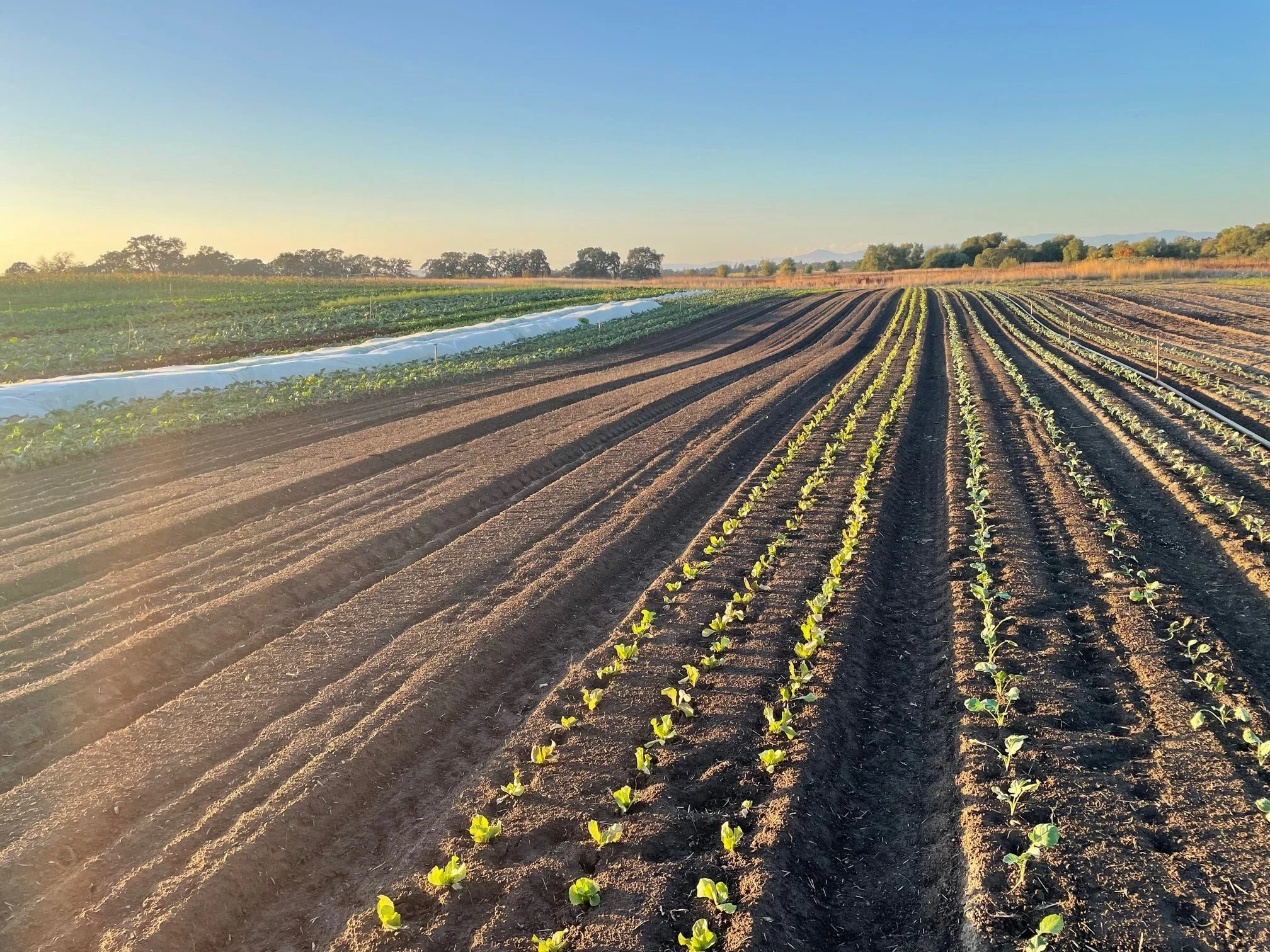THIS WEEK’S HARVEST
It’s Kimchi week!
Bintje Potatoes, Napa Cabbage, Scallions, Daikon, Romance Carrots, Early Girl Tomatoes, Spinach, Assorted Lettuces, Purple Bok Choi, Black Magic Dino Kale, Fennel, Assorted Zucchini & Summer Squash, Sweet Peppers, Poblano Peppers
U-PICK
Don’t forget to branch out to the back areas to find the jack-pots!
Albion Strawberries | 4 pints per share
Padrón Peppers | Gleanings
Shishito Peppers | Gleanings
Cherry Tomatoes | Gleanings
🌟 Goldilocks Beans | 3 pints per share | Fancy golden beans — our last succession of “green beans”
Dragon Tongue Green Beans | Gleanings
Hot Peppers:
Jalapeños | 5 peppers per share | To find the hottest ones, look for “checking”, the delicate cracks in the skin that indicate the pepper has aged into its heat, or pick the red ones for a sweet and spicy flavor.
Thai Chilis | 10 peppers | Pick when red
Habanero | 20 peppers per share | Pick when orange
Herbs: Italian, Purple and Thai Basil, Dill, Tulsi, Chamomile, Parsley, Onion Chives, Garlic Chives, Tarragon, Thyme, Oregano, Marjoram, Culinary Sage, Lemon Balm, Lemon Verbena, Vietnamese Coriander, Shiso (Perilla), Catnip, Pineapple, Sorrel, Assorted Mints & Husk Cherries!
Flowers!
PUMPKIN PATCH OPENS OCT. 12TH!
Spooky season is here and with it our 8th annual pumpkin patch! The pumpkins did really well this year and we’re excited to introduce a couple new odd-shaped varieties! Find your Jack-O next weekend!
Alice enjoying the Pumpkin patch last year.
HARVEST NOTES
Napa Cabbage & Kimchi: Welcome to Kimchi week, the week when Kayta’s magical crop planning skills make Napa Cabbage, Scallions, and Daikon Radish align together on the harvest table! We’ll include a recipe below for classic mak kimchi, where the cabbage is chopped before being seasoned. For a more mellow version without red pepper, check out this white Kimchi recipe sent to us by CSA member Robin Kim. Robin made a vegan version of the white Kim-chi recipe for us last year that was one of our all-time favorite farm preserves. She substituted the salted shrimp and fish sauce with Bragg’s aminos / soy sauce and also omitted the alliums. It was mellow but still packed with flavor. For the jujubes, chestnuts, pine nuts, and rice flour, Robin recommends visiting Asiana Market in Cotati or Asia Mart in Santa Rosa.
This is like the last week of both Tomatoes and Summer Squash & Zucchini! We hope you’ve eaten your fill and are ready to turn to the cool, crisp crops of Fall with us.
POTATO HARVEST PARTY!
Saturday, October 12th, 9:00 am - 11:30 am
Join us for our 8th annual potato harvest party! There’s nothing like watching potatoes shower up out of the ground behind the wake of the tractor and then getting dirty and bagging them with friends. It’s an unforgettable experience, especially for the kiddos.
All abilities and interests welcome. Feel free to bring non-members. We recommend a sunhat, water bottle, and clothes you don’t mind getting dirty. Some people prefer using light gloves. We’ll have some light refreshments, music from the boombox, and agrarianly awesome time. (For new folks: This potato harvest is not required in any way for members to enjoy potatoes, we will be distributing the tuberous bounty all year whether or not you come to harvest!)
KIMCHI RECIPE
by Amy Kim of Kimchi Mom, via Steamy Kitchen
INGREDIENTS
7 pounds of napa cabbage
about 1/3 cup kosher salt
1 cup sweet rice flour (Mochiko is a popular brand)
2 cups water
3/4 cup red pepper flakes, medium coarseness
1/4 cup chopped saewoo jjut (salted shrimp)
3 tablespoons fish sauce
A scant 1/2 cup sugar
5-7 stalks green onion, chopped
2 ounces ginger (2-inch long, 1-inch diameter piece), minced
8-9 medium garlic cloves, minced
3 medium carrots, julienned
1 medium-sized daikon or 1 small mu (Korean radish), thinly sliced in 2-inch sections
water
INSTRUCTIONS
Preparing the sweet rice flour paste:
Whisk together the sweet rice flour and water in a small saucepan. Keep whisking the mixture until bubbles form on the surface. Once this occurs, take the saucepan off the heat and set aside to cool.
Preparing the cabbage:
Discard any wilted or discolored leaves. Starting at the base of the stem, cut the cabbage about one-third of the way down. Then pull apart the cabbage halves to completely separate them. Do the same with the halved portions - cut and pull apart. Repeat for all the cabbage heads. At this point, you can give the quarters a quick rinse under running water and shake off any excess water.
Trim the core at a diagonal. Cut the quarters into 2-inch wide pieces and place in an oversized bowl (I used a 12 qt. bowl) or use a couple of large bowls. Sprinkle generously with salt. Alternate layers of cabbage and salt. Once all the cabbage is cut, give the cabbage a toss and sprinkle more salt on top. Place a weight on top of the cabbage. Two dinner plates works well for me.
Let the salted cabbage sit for at least 3 hours. Don't worry if you go over (in the video, I let mine sit overnight since I couldn't tend to it at 3 hours). After 1 hour, give the cabbage another toss.
Preparing the sauce:
While the cabbage is close to being ready, prepare the red pepper sauce. In a medium bowl, mix kochukaru (red pepper flakes), water, saewoo jjut, fish sauce, green onions, sugar, ginger, garlic, rice flour paste, and about a 1/2 cup water. Mix thoroughly. Taste. It should be balanced – not too salty, not too fishy, not to spicy and not too sweet. Adjust seasonings at this point. The consistently should be akin to very thick batter. Add a bit more water if necessary. Mix in carrots and radish. Set aside.
Once the cabbage is ready (the volume of the cabbage should have decreased, and it should be a bit wilted), rinse the cabbage under cold running water and let drain in a colander. Once drained, place the cabbage in a large bowl.
At this point you may want to put clean plastic gloves on especially if you have sensitive skin. Add the sauce to the cabbage. Thoroughly mix the sauce and cabbage and make sure every piece of cabbage is coated with the red pepper sauce. Taste. If it needs more salt, add a bit of fish sauce. But you don’t want it to be too salty.
Transfer the cabbage mixture into a large glass jar. Press down on the cabbage as you are filling the jar. Leave about 1-inch of space from the top.
Don’t throw the empty bowl in the sink just yet. Pour in about 1 cup of water into the bowl. Add about a teaspoon of salt to start, and stir. Swirl the water around to make sure you get all the remaining pepper mixture. Taste. Again, you don’t want it too salty – just a hint of salt. Fill the jar with the water until it barely covers the cabbage.
Press down on the cabbage again and make sure the liquid has made its way throughout the jar. Close the lid tightly.
Leave the jars at room temperature** for about a day away from direct sunlight. I leave mine out for about 24-30 hours. This is when the magic happens. You may want to place the jar in a shallow bowl or plate in case there is leakage.
After those 24 or so excruciating hours, sample the kimchi. There should be a slight tang. At this point it is ready to be refrigerated. You can eat the kimchi right away, but I prefer to wait at least a week to indulge. The kimchi will continue to ferment at a much slower pace in the refrigerator and will keep for about 4 weeks. The kimchi will turn really sour at this point and if you have any left in the jar, it will be perfect for jigae, fried rice, ramen or jun.
WINTER SISTER FARM CSA
Going to miss us this winter? Well you’re in luck! Our dear friends next door at Winter Sister Farm have got you covered with the freshest veggies money can buy all winter and spring.
All memberships include diverse winter-hardy veggies such as broccoli, carrots, potatoes, onions, winter squash, lettuce, kale, chard, as well as access to a small u-pick garden with cold hardy herbs and spring flowers. Click here to get all the details on this wonderful CSA program and to reserve your spot today!
Aisling loading up the last of our Napa Cabbage harvest Friday morning.
FARMER’S LOG
This week felt a little like the calm before the storm — the storm of the last mid-October push of potato, winter squash, and corn harvests, and the liminal shoulder season work of garlic planting, compost spreading and cover cropping before the rains.
We continued chipping away at our 9,000 ft of potatoes; we kept our fresh vegetable fields extra wet so they could contend with this heat wave — hopefully the last gasp of summer.
We’ll leave you this evening with the carefully and heartfully placed words of Mary Oliver.
Lines Written in the Days of Growing Darkness
by Mary Oliver
Every year we have been
witness to it: how the
world descends
into a rich mash, in order that
it may resume.
And therefore
who would cry out
to the petals on the ground
to stay,
knowing, as we must,
how the vivacity of what was is married
to the vitality of what will be?
I don’t say
it’s easy, but
what else will do
if the love one claims to have for the world
be true?
So let us go on
though the sun be swinging east,
and the ponds be cold and black,
and the sweets of the year be doomed.
* * * * *
See you in the fields,
David
CSA BASICS
Drive slow! Please drive slow on Cooper Rd. and in our driveway / parking lot area. Kids at play!
No dogs: Unfortunately, dogs are not allowed on the farm.
What time is harvest pick-up?:
Saturday harvest pick-ups run from 9:00 am - 2:00 pm
Tuesday harvest pick-ups will run from 1:00 pm - 6:00 pm
Oriented members can come to the farm any time, 7 days a week, sunrise to sunset, to u-pick and enjoy the farm.
Where is the farm? The member parking lot is located at 1720 Cooper Rd., Sebastopol, CA 95472.
Where is the food? The produce pick-up barn is just to the right of the solar panels and above our big greenhouse. You can’t miss it!
2024 CSA program dates: Our harvest season will run from Saturday, June 15th through Tuesday, December 10th this year.















